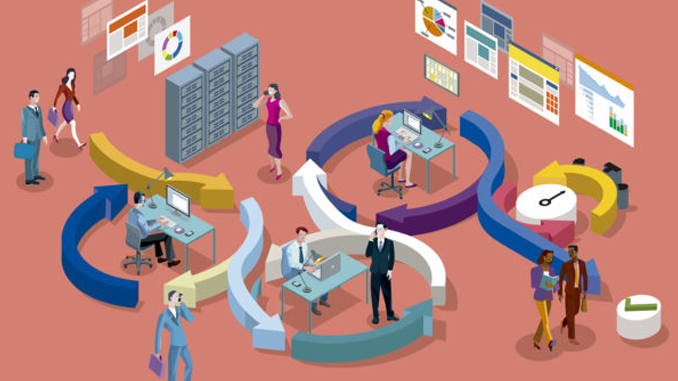
Agility Guide: A How-To for Navigating Tech Transformations
In the race to modernize, many insurers have found their progress slowed by the size, scale and scope of large transformation programs. From core systems to data warehouses, and from cloud platforms to customer-facing services and apps, some insurers are struggling to get to the finish line.
Executive Summary
Asking the right macro-level questions up-front is a key part of the introduction of new technologies in large transformation efforts that insurers miss. Here, X by 2 consultants provide some examples of questions to ask along with a checklist of helpful do’s and don’ts to handle early naysayers and inevitable detours and course-corrections along the way.
There are many reasons for this, but more importantly there are methods and approaches to address the many issues insurers may face—and they’re applicable for those insurers that are just beginning their transformational journey or those insurers in the midst of it.
For the purposes of this short primer, a large transformation program is defined as: an effort that includes one or more core insurance functions; is technically complex in terms of scope, scale and duration; and results in significant changes for all stakeholders—customers, agents and employees.
Hit the Right Key(s)
Taking the wrong approach from the start can doom a transformation program to suboptimal results, so it’s critical to establish a solid foundation of program principles and elements as follows:
- Establish core objectives. Establishing a few (but not more than several) core objectives for the program helps to anchor the overall effort and will serve as the key milestones along the way.
- Adopt a product mindset. Break down the transformational program into a series of several product deliveries. It’s a subtle but key shift that allows the teams involved to think and act in concert with the long-term objectives but implement and deliver new functionality incrementally.
- Think like a startup. Use an MVP (minimum viable product) approach to bring in stakeholders early and often, allowing them to be hands-on with new development. In this way functions or interfaces that aren’t well-received can be changed and iterated quickly, rather than waiting and having to retrofit after a more formal delivery.
- “It’s the communications, stupid.” Engage stakeholders early, often and forever. The more they’re involved, the less the inevitable changes will be resisted.
The Goldilocks Road Map
A road map is not a project or program plan where false assumptions are made about what will happen in the future. Rather, it’s the framework that facilitates an agile approach to the effort.
It provides structure for creating teams, breaking down development efforts, and making decisions about scope and scale. If a road map is too broad, it won’t be seen as consumable or achievable; if it’s too narrow, it will be seen as too tactical in nature. It has to be just the right size, and that only happens after an “Inception Phase” analysis of the business and technology current state challenges matched against the desired state goals and objectives.
Road maps are the navigational tools for the transformation journey and as such must be adaptable and flexible to whatever head winds or squalls pop up—and they will pop up. Road maps should also be built with opportunities for early and quick wins that help to create momentum and build morale for the overall effort.
You Can’t Score if You Don’t Shoot
Large transformations are often about introducing new technologies into the environment. In fact, given the time, resources and efforts that insurers commit to transformation projects, it almost seems negligent not to leverage newer technological approaches to traditional insurance processing issues. The truth of the matter is that by the time the overall transformation is completed, many of the new technologies introduced will have become mainstream solutions. That said, new technologies should never be introduced for their own sakes but rather should be used to materially advance and achieve the core objectives of the transformation. Additionally, newer technologies should always be put through proof-of-concept exercises to be sure of their fit and long-term value, and once validated, they should be exposed early and often to those stakeholders impacted.
However, the introduction of newer technologies in a large transformation effort should always be couched in the answers to a few macro-level questions—questions that many insurers often get wrong or don’t ask at all. Questions such as:
-
- Should we be customer-centric? Many insurers are still policy-centric.
- Should we be real-time and event-driven? Many insurers are still batch-oriented in process and mindset.
- Do we have/desire a modern infrastructure? Look to the cloud for infrastructure transformation.
- Do we ask our users to enter data we could be automatically providing? Look at online agencies or comparative raters for inspiration.
- Do we focus on the entire user journey? Nice kitchen, but have you seen the basement?
These are just a few of the kinds of questions that should be asked and answered early because they all represent fundamental directions and approaches that will persist over time. For example, many insurers are still batch-oriented, not only in their technology platforms and processes but in their culture and customer approaches. If an insurer is going to change that and move from a policy-centric orientation to a customer-centric one, nearly everything—technologies, processes, services, and employee and agent culture—must change. In that context, the technology changes become the “easy” part.
Putting It All Together
The biggest key to any transformation program is to make sure that those stakeholders being transformed by the modernized systems and platforms are fully and completely on board. Business and technology visionaries are essential, but just as essential are the incumbent subject matter expert-skeptics, as they’re the ones who really need convincing. Identify these SMEs and pull them in early. Listen to their concerns and heed their advice about the impact of the transformational changes. Winning them over and turning them into the champions for the effort, while not a guarantee of technological success, can go a long way toward cultural buy-in and transformation.
Accomplishing the above will also help prepare the organization to become nimble and adaptive, inclusive of a readiness to meet the challenges from the unexpected issues and opportunities that inevitably arise over the course of a long transformation program. Also, it’s critical to conduct regularly scheduled and all-inclusive stakeholder meetings where progress is charted and explained and where stakeholders are hands-on with working demos of prototyped software.
Finally, there should be a constant conversation around change management. The last thing any stakeholder wants is a surprise change in requirements, or functionality, or target dates, etc. To avoid this, communicate often, clearly and broadly across the organization. Successfully navigating and implementing a large transformation program is no easy feat, but keeping this checklist in mind can increase the chances of ultimate transformational success.
Originally published in
Carrier Management Magazine
Read the original article here.
Related Articles
-
The fear some clients have around moving to the cloud is often based on a misunderstanding of what cloud services have to offer.
Read More -
In just a few short years, information technology has gone from tactical, to strategic, to existential in nature.
Read More -
Core systems modernization, Cloud and Mobility strategies, and investments in Insurtech startups are just a few of the ways insurers are re-positioning.
Read More



